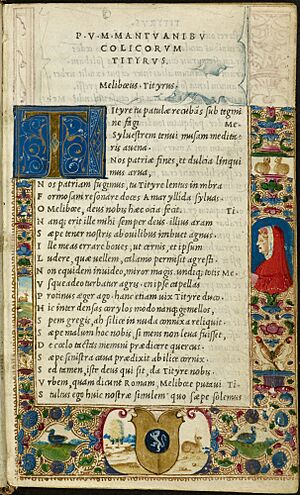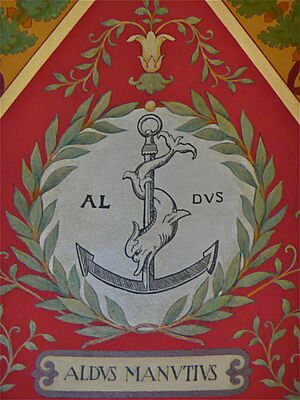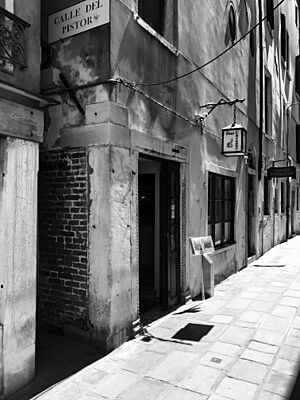Aldine Press facts for kids

The Aldine Press was a special printing company. It was started by a man named Aldus Manutius in 1494. This company was located in Venice, Italy. The Aldine Press became famous for printing classic books. These books included masterpieces from ancient Greek and Latin writers. They also printed some newer works. The first book with Aldus's name on it came out in 1495.
The Aldine Press is very important in the history of typography. Typography is the art of designing letters for printing. One big reason for its fame is that it introduced italics. The press was also the first to print books in a small size called octavo. This size was like today's paperbacks. It made books easy to carry and read anywhere.
Aldus Manutius ran the press for twenty years. During that time, they printed 132 books. Aldus passed away in 1515. After his death, his wife Maria and her father Andrea Torresani continued the business. Later, Aldus's son, Paulus, took over. His grandson, Aldus Manutius the Younger, then managed the company until 1597. Today, old books printed by the Aldine Press are called Aldines. The special letter styles they created are also known as Aldines.
The Aldine Press had a special right to print Greek books in Venice. This was like having a copyright in that area. However, it was harder to protect their books outside Venice. Many fake copies were made in places like Lyon. This affected their business success.
Contents
How the Aldine Press Began
Aldus Manutius, who started the Aldine Press, was a scholar and a teacher. He loved old books and learning. Manutius met Andrea Torresani, who had bought printing equipment. This equipment came from the wife of Nicolas Jenson, another famous printer.
The printing company was first owned by two people. One half belonged to Pier Francesco Barbarigo. He was the nephew of Agostino Barbarigo, who was the leader of Venice at the time. The other half belonged to Torresani. Manutius owned a small part of Torresani's share. Manutius was mostly in charge of the scholarly work and editing. Barbarigo and Torresani handled the money and daily operations.
In 1496, Manutius set up his own printing location. It was in a building called the Thermae in Venice. Today, this spot is a restaurant. Manutius lived and worked there. It was also home to the "New Academy." This was a group of Manutius's friends and editors. They worked together to translate Greek and Latin texts.
In 1505, Manutius married Maria, Torresani's daughter. This marriage brought their business shares together. After marrying, Manutius lived at Torresani's house. In 1506, the Aldine Press moved to Torresani's house. This building was later torn down in 1873. A bank now stands in its place in Venice.
Amazing Achievements of the Press
Manutius started the press because he loved classic books. He also wanted to help save Greek studies. In its early years, the press printed new copies of works by Plato, Aristotle, and other Greek and Latin classics.
The Aldine Press printed the first edition of Plato's works. This special edition was dedicated to Pope Leo X. It included a poem and the life story of Plato. These were also in other early editions of Plato's works.
Manutius also printed dictionaries and grammar books. These helped people understand the classic texts. Scholars who wanted to learn Greek used them. They would also hire Greek speakers to teach them directly. Some historians believe that the fall of Constantinople in 1453 put Greek learning at risk. But publications from the Aldine Press helped save it. Erasmus, a famous scholar, worked with the Aldine Press. They made sure texts were translated accurately. The Aldine Press also started printing books in modern languages, like Italian and French.

New Typefaces for Books
Manutius wanted to make better fonts for his books. He hired Francesco Griffo to design and cut new typefaces. These fonts were based on the beautiful handwriting of Renaissance scribes. Griffo made his own improvements. This led to one of the earliest roman typefaces.
The First Italic Type
Manutius and Griffo then created a slanted version of this font. This was the very first italic type. The word italic comes from early Italian versions of this font. Italic type was first used by the Aldine Press in 1500. Their 1501 edition of Virgil's Opera was the first book printed entirely in italic type. The roman and italic fonts created by Manutius and Griffo greatly influenced how typefaces developed.
Books You Could Carry (libelli portatiles)
Starting in 1505, Manutius began making plain texts in a small, portable size. He called them enchiridion, meaning "handbook." These small books were not cheap. But they cost much less than the large, heavy books of that time. These portable books had the edited text without extra comments. They were printed in a font that looked like cursive handwriting. They were small enough to hold comfortably in one hand. These portable books made it easier for people to access classic literature. People no longer had to go to a library to read a big book. Now, the book could come with them!
The Dolphin and Anchor Symbol
In 1501, Aldus started using a special symbol for his press. It was a dolphin wrapped around an anchor. This symbol came from a silver coin. The coin was from the time of the Roman Emperor Vespasian. The dolphin and anchor symbol came with a saying: "Festina Lente." This means "make haste slowly." This became the motto for the Aldine Press.
After Aldus Manutius (1515 onwards)
Aldus Manutius passed away on February 6, 1515. After his death, Torresani and his daughter Maria, Aldus's widow, ran the company. The press's name changed in 1508 to "In the House of Aldus and Andrea Torresano." It kept this name until 1529.
In 1533, Paulus Manutius, Aldus's son, took over. He restarted the company and changed its name to "Heirs of Aldus and Andrea Torresano." In 1539, the name changed again to "Sons of Aldo Manuzio." Finally, in 1567, Aldus Manutius the Younger, Aldus's grandson, took charge. He continued the business until his death.


